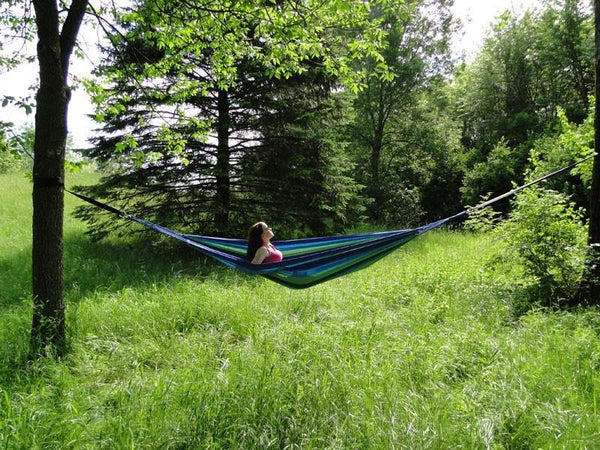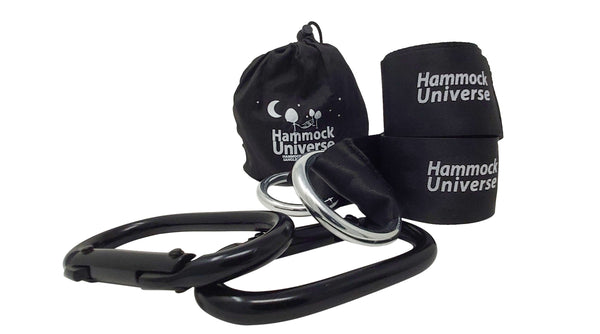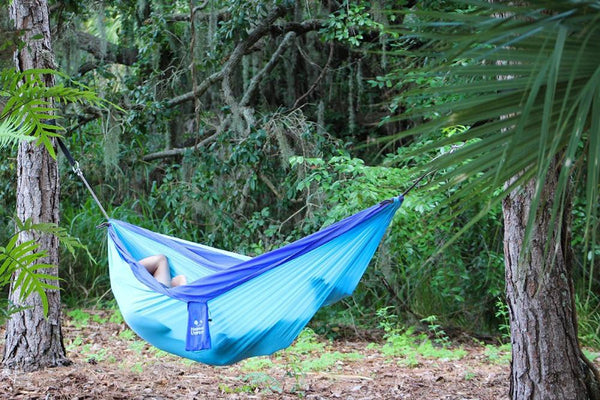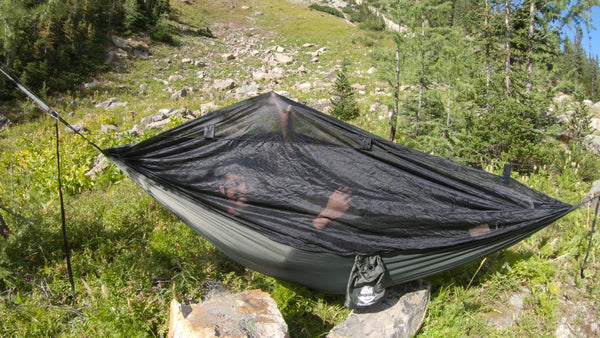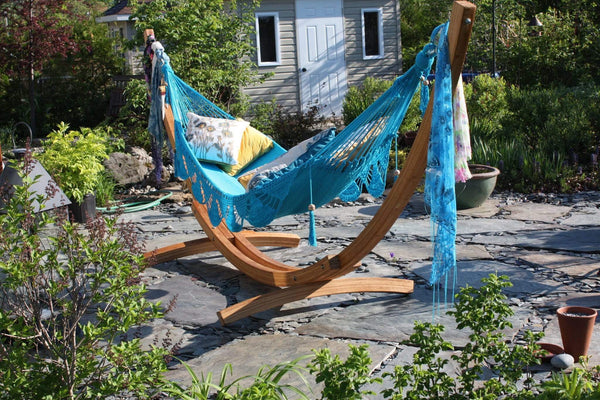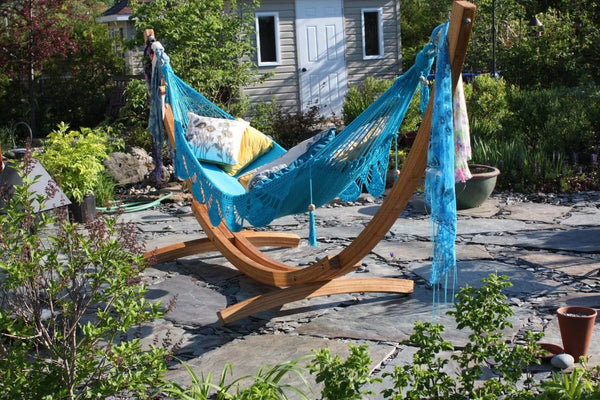FREE SHIPPING on most orders $25+ HAMMOCK BUYING GUIDE
Menu
-
-
Hammocks
-
Hammock Stands
-
Hammocks with Stands
-
Hanging Hammock Chairs
- View all Hammock Chairs
- Brazilian Style Hammock Chairs
- Colombian Hammock Chairs
- Mayan Hammock Chairs
- Mayan Hammock Chairs Deluxe
- Universal Hammock Chair Stand
- U Hammock Chair Stand
- Brazilian Hammock Chair with Universal Chair Stand
- Colombian Hammock Chair with Universal Chair Stand
- Mayan Hammock Chair with Universal Chair Stand
- Mayan Hammock Chair Deluxe with Universal Stand
-
Accessories
- Gift Cards
- Tools and Guides
- Bargain Bin
-
- 1-800-207-4761
- Login

FREE SHIPPING on most orders $25+ HAMMOCK BUYING GUIDE
Eco-Friendly Camping: Leave No Trace
October 16, 2024 8 min read
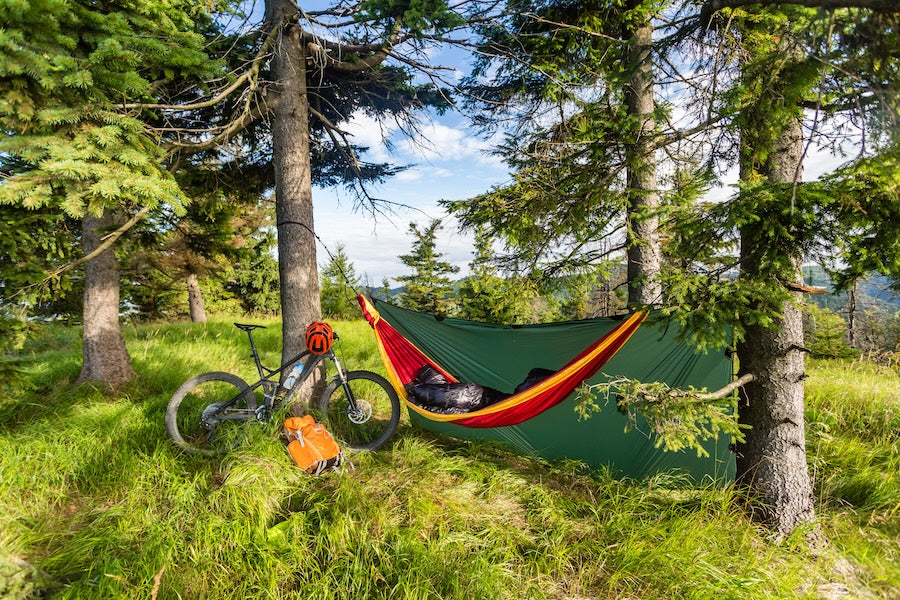
Audio Version
Camping is one of the best ways to connect with nature, but it’s essential to make sure we’re not harming the environment in the process. As more people head outdoors to enjoy the wilderness, the impact on our natural spaces becomes more noticeable.
This is why eco-friendly camping is more important than ever. It’s about enjoying the great outdoors while leaving it as pristine as you found it - or better.
One of the most popular guidelines for responsible camping is the "Leave No Trace" principle. These simple but effective rules help campers reduce their environmental footprint. By following the Leave No Trace guidelines, you can help protect the landscapes, wildlife, and ecosystems that make camping so special. Whether it’s choosing eco-friendly gear, managing waste properly, or being mindful of your campfire, every small action counts.
For example, hammocks are a great way to make your camping experience more sustainable. They’re lightweight, easy to set up, and don’t require you to disturb the ground as much as tents do. With tree-friendly straps, you can hang a hammock without damaging the trees or the surrounding environment. But more on that later.
Understanding the Leave No Trace Principles
When it comes to eco-friendly camping, the Leave No Trace principles serve as a reliable guide to minimize your impact on the environment. These seven core principles offer simple actions you can take to ensure that nature remains untouched for future campers to enjoy.
1. Plan Ahead and Prepare: Before heading out, research your destination and plan carefully. Know the regulations, pack appropriate gear, and anticipate potential challenges. Proper planning helps prevent accidents and environmental damage, like getting lost or needing to clear new paths.
2. Travel and Camp on Durable Surfaces: Stick to established trails and campsites. When you camp on durable surfaces like gravel, sand, or rock, you protect the delicate plants and ecosystems beneath your feet. Avoid setting up camp on soft, natural surfaces, which can be easily damaged.
3. Dispose of Waste Properly: Pack it in, pack it out. This principle is crucial for keeping natural spaces clean. Take all your trash with you and dispose of human waste properly by burying it in a cat hole or using designated waste bags. It’s also important to pack out any food scraps, which can harm wildlife.
4. Leave What You Find: Resist the urge to collect souvenirs from nature. Leave rocks, plants, and natural objects where they belong. Preserve the beauty of the outdoors for others to enjoy, and don’t disturb historical or cultural sites.
5. Minimize Campfire Impact: Use a camp stove instead of a traditional campfire when possible. If you do have a fire, use existing fire rings and keep the fire small. Make sure it is completely extinguished before you leave.
6. Respect Wildlife: Observe animals from a distance and avoid feeding them. Human food can harm animals and disrupt their natural behaviours. Respect their space and habitats.
7. Be Considerate of Other Visitors: Enjoy the outdoors in a way that doesn’t disturb others. Keep noise levels low and give other campers plenty of space to enjoy nature. A little courtesy goes a long way in making the outdoor experience pleasant for everyone.
These principles are simple to follow and play a critical role in preserving the natural beauty of outdoor spaces. By following them, you help protect the environment while enjoying all that nature has to offer.
Choosing Eco-Friendly Gear for Sustainable Camping
The gear you bring can make a big difference in how eco-friendly your camping trip is. Opting for sustainable, reusable, and energy-efficient gear reduces your environmental impact and helps you camp more responsibly.
One of the most important things to look for is gear made from sustainable materials. Items like tents, sleeping bags, and clothing made from recycled fabrics or organic cotton are great choices. These materials reduce waste and lower the carbon footprint associated with production. Reusable gear, such as stainless steel water bottles and food containers, also helps reduce single-use plastics, which can pollute wilderness areas.
For power, consider solar-powered devices. From portable solar panels to solar-powered lanterns and chargers, these devices allow you to enjoy modern conveniences without relying on disposable batteries or fossil fuels. Solar energy is clean and renewable, making it perfect for an eco-conscious camping trip.
Cooking gear is another area where you can make eco-friendly choices. Biodegradable soaps and cleaning products help reduce the amount of harmful chemicals that enter water systems. Opt for cookware made from stainless steel, cast iron, or aluminium - durable options that can last for many trips without needing replacement.
Pro tip: pack layered, moisture-wicking garments made from natural fibres like merino wool or hemp. These are highly functional, keeping you comfortable in varying weather conditions.
Hammocks vs. Tents: A Sustainable Sleeping Option
When it comes to eco-friendly camping, your choice of sleeping setup can make a significant difference.
Tents have been the go-to option for decades, but hammocks are becoming an increasingly popular alternative. One of the main reasons for this shift is their minimal environmental impact. Setting up a tent often requires clearing the ground, which can disturb vegetation and soil. Even when using designated campsites, tents can leave a mark on the environment, especially if they are pitched in the same spot over and over again.
Hammocks, on the other hand, offer a lightweight, eco-friendly option.
They don’t require disturbing the ground at all. Instead of flattening plants or compacting the soil, a hammock keeps you suspended above the forest floor, leaving no trace behind. This is especially important in delicate ecosystems where even light foot traffic can cause long-term damage. A hammock allows you to camp responsibly, with minimal impact on your surroundings.
Using a hammock with tree-friendly straps is key to ensuring you don’t harm the trees. Look for straps that are wide and designed to protect the bark, avoiding any damage to the tree’s structure. Hammocks are also easier to pack and carry, reducing the need for bulky camping gear that often requires more energy and materials to produce and transport.
Whether you’re camping deep in the woods or closer to home, hammocks offer a sustainable, comfortable option that aligns with eco-friendly values.
Read More: Hammock Vs. Tent Camping
Proper Waste Management in the Wilderness
One of the biggest challenges of eco-friendly camping is managing waste responsibly. When you’re out in nature, it’s important to leave the area as clean as, or cleaner than, you found it. The “Pack In, Pack Out” rule is a simple guideline to follow: whatever you bring into the wilderness, you must take out. This applies to everything from food packaging to toiletries.
Reducing waste starts with smart packing. Opt for reusable containers and avoid single-use plastics, which can take decades to break down and are harmful to wildlife.
Managing human waste is also crucial when camping. If you’re in a backcountry area without facilities, bury your waste in a cat hole at least 15 to 20 cm deep and at least 60 metres away from any water sources. Use biodegradable toilet paper and natural soap products to avoid contaminating the soil or water. Some eco-conscious campers opt for portable toilet systems, which allow you to pack out human waste and dispose of it properly when you return to civilization.
Food waste should never be left behind, as it can attract animals and disrupt local ecosystems. Even seemingly harmless items like fruit peels can take months to decompose and may harm wildlife that isn’t accustomed to them. Use airtight containers to store your food and minimize packaging to reduce waste. Consider meal planning carefully, so you bring just what you need and avoid leftovers that could be difficult to manage.
Minimizing Campfire Impact: Responsible Fire Practices
A campfire can be one of the highlights of any camping trip, but it can also have a significant impact on the environment if not managed responsibly. Traditional campfires can damage soil, kill plant life, and leave behind unsightly scars on the landscape. Not to mention, improperly extinguished fires can cause wildfires, endangering entire ecosystems. Minimizing your campfire’s impact is key to practising eco-friendly camping.
The first step is to consider alternatives. Portable stoves are a great option for cooking without leaving a trace. They’re easy to use, efficient, and much safer in environments where open flames are risky. If you do choose to build a campfire, use established fire rings or fire pits where possible. These reduce the need to disturb new areas and help contain the fire, keeping the environment safer.
It’s important to gather firewood responsibly. Avoid collecting wood from the surrounding area, as downed trees and branches play an essential role in local ecosystems. Instead, use wood from designated suppliers or bring your own. This prevents the removal of natural habitats for insects and small animals.
Keep the fire small and controlled. A large, roaring fire may look great, but it burns more fuel and poses a greater risk to the environment. A small, controlled fire is just as enjoyable and far less destructive.
When it’s time to leave, make sure the fire is completely extinguished. Use water to drown the embers, and stir the ashes until they’re cool to the touch. Never leave a fire burning unattended, even if it looks like it’s almost out.
Respecting Wildlife and Their Habitats
Sharing the outdoors with wildlife is one of the most rewarding parts of camping. However, it’s crucial to respect their space and ensure your presence doesn’t disrupt their natural behaviours.
Animals rely on their environment for survival, and human interference can cause unnecessary stress or even harm.
One of the most important rules for respecting wildlife is to keep your distance. It can be tempting to approach animals for a closer look or photograph, but this can disrupt their feeding, nesting, or resting routines. Always observe wildlife from a safe distance, using binoculars if you want a better view. Remember, you’re in their home, and it’s important to respect that boundary.
Proper food storage is another way to protect both wildlife and yourself. Leaving food out in the open can attract animals, leading to dangerous situations for both parties. Use bear-proof containers or hang food from a tree to ensure it’s out of reach. Not only does this prevent animals from becoming reliant on human food, but it also keeps them from venturing too close to your campsite.
Avoid feeding wildlife at all costs. Human food can upset their natural diets and make them sick. Feeding animals also encourages them to associate humans with food, leading to more frequent and dangerous encounters. Keep your campsite clean, and pack away all food scraps and waste. This will help maintain the balance of the local ecosystem and ensure that wildlife stays wild.
Respecting natural habitats is just as important as respecting the animals themselves. Avoid trampling vegetation or disturbing nests, dens, or burrows. Stick to designated trails and camping areas to minimize your impact. The less we interfere with wildlife and their surroundings, the more likely it is that future campers will be able to enjoy these natural spaces in their undisturbed beauty.
Read More: How To Hammock Camp?
Conclusion: Camp Sustainably for Future Generations
Eco-friendly camping is about more than just enjoying nature - it's about protecting it. By adopting sustainable practices like following the Leave No Trace principles, choosing environmentally responsible gear, and minimizing your impact on wildlife, you help preserve the beauty of the outdoors for future generations.
It’s the little things, like packing out all your waste or using a hammock instead of a tent, that can make a huge difference.
Small changes in how you camp can add to a big positive impact. Hammocks, for example, offer a comfortable, low-impact alternative to traditional camping setups, helping you reduce your footprint while still enjoying a good night’s sleep. Whether you’re managing waste responsibly, reducing campfire impact, or respecting the habitats of wildlife, every action counts.
The future of outdoor spaces depends on the choices we make today. Camping sustainably ensures that these natural spaces remain beautiful, unspoiled, and available for everyone to enjoy.
So, next time you plan a trip, think about the steps you can take to leave nature just as you found it - or even better. Sustainable camping is not just about your own experience - it's about leaving a legacy for those who come after you.
Safety First!
When using a hammock*, safety is paramount. Please make sure to follow these important guidelines when purchasing, installing and using a hammock
*(includes Hammock, Hammock Chair, Hammock Stand and Hammock Accessories)
Safety First!
When using a hammock*, safety is paramount. Please make sure to follow these important guidelines when purchasing, installing and using a hammock
*(includes Hammock, Hammock Chair, Hammock Stand and Hammock Accessories)
Related Products
Want to relax?
Join for exclusive content and promotions we only give to our email list!
